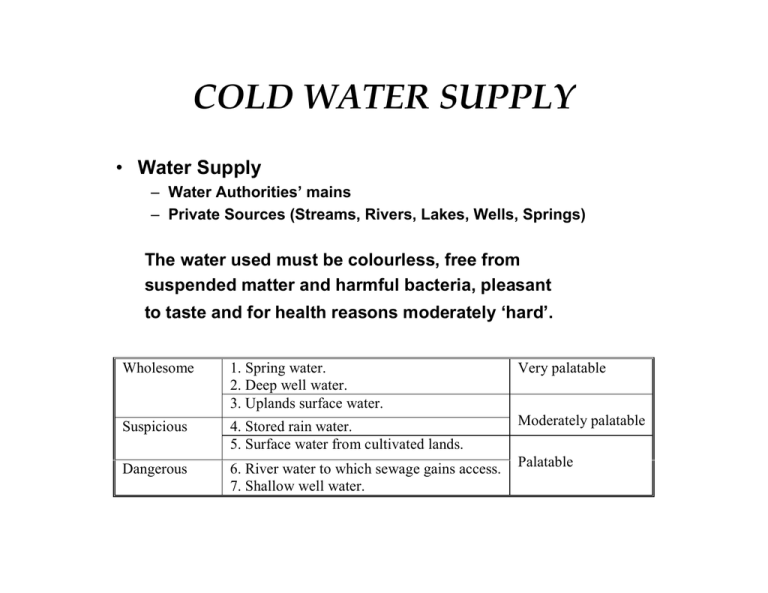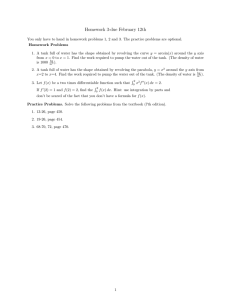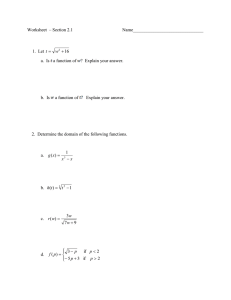Chp2-Cold water Supply
advertisement

COLD WATER SUPPLY • Water Supply – Water Authorities’ mains – Private Sources (Streams, Rivers, Lakes, Wells, Springs) The water used must be colourless, free from suspended matter and harmful bacteria, pleasant to taste and for health reasons moderately ‘hard’. Wholesome 1. Spring water. 2. Deep well water. 3. Uplands surface water. Very palatable Suspicious 4. Stored rain water. 5. Surface water from cultivated lands. Moderately palatable Dangerous 6. River water to which sewage gains access. 7. Shallow well water. Palatable COLD WATER SUPPLY Mains Distribution: Water board: domestic – fully treated. Water board: industrial – partially treated usually chlorinated. Large industrial complexes may provide and treat their own supply. The following is an example of water treatment for producing high quality water for homes. Pump Sea Desalination Plant (e.g. Reverse Osmosis) Water Supply COLD WATER SUPPLY Service Reservoir: This is a large water tank sited to give ideal range of static head where possible (30m-70m) height. 70 SERVICE RESERVIOR 30 WATER. MAINS Note: 1m head = 9.8 kN/m2 Pressure, P = ρ × g × h ideal range of the head. COLD WATER SUPPLY Water Tank Water meter Stop cock Mains Service pit Communication Pipe Distribution Pipe Service Pipe COLD WATER SUPPLY Storage capacity per person for different building types Type of Building Storage per person (Liters) Dwelling houses and flats Hostels Hotels Offices without canteens Offices with canteens Restaurants Day Schools Boarding schools Nurses homes and medical quarters 91 91 136 37 45 7 27 91 114 Volumes of water used by each appliance Appliance Volume of Cold water (Liters) Wash basin Hand wash Wash Hair Wash 5 10 20 40 110 10 150 Wash up Cleaning 15 10 Shower Bath W.C Washing Machine Sink COLD WATER SUPPLY • Example: You are designing a boarding school of 200 students and staff. What should be the volume of the cold water tank? • Solution: From the first table for a boarding school the storage required is 91 Litres per person. Therefore the total volume required is: Volume = 91 L/person x 200 = 18200 L This is the same as 18.2 m3 or 18.2 Tons of water (Note: 1 m3 = 1000L) COLD WATER SUPPLY US standards for drinking water PARTICLES WITHIN WATER RECOMMENDED LEVEL Aluminum Chlorite Co lour Copper Corrosivity florid Small particles Iron Manganese Odor Silver Sulphate Total dissolved particles Zinc 0.05-0.2 mg/l 250 mg/l 15 co lour unit 1 mg/l Non corrosive 0.2 mg/l 0.5 mg/l 0.3 mg/l 0.05 mg/l 3 threshold number 0.1 mg/l 250 mg/l 500 mg/l 5 mg/l Hardness takes place above this value COLD WATER SUPPLY WATER HARDNESS Scaling COLD WATER SUPPLY • Water Supply – HARDNESS OF WATER (Difficult to obtain a lather with soap) » Two types of hardness: 2. Permanent 1.Temporary can be removed by boiling the water can not be removed by boiling the water » Temporary hardness causes scaling or furring but permanent hardness will not cause scaling or furring, unless the water is brought to high temperatures and pressures. However it may cause corrosion. COLD WATER SUPPLY NON-RETURN VALVE BY-PASS VALVE Water softener Base exchange process: ¾ Removes both temporary and permanent hardness very efficiently by passing the water through zeolites contained in a cylinder. 6 SOFT WATER OUTLET Hard water inlet SALT CAP Inlet To backwash, valves 1,2,5,6 closed valves2 and 3 open 1 3 Back wash pipe 5 meter 4 softening Zeolite Strainer The process is as follows: Sodium Zeolite + Calcium Sulphate (or Carbonate) (in softener) (in water) becomes Calcium Zeolite + Sodium Sulphate (or Carbonate) (held in softener) (in solution with the water but harmless) waste COLD WATER SUPPLY Water softener Back wash: After a period of use the sodium zeolite is converted into calcium and magnesium zeolite, thus losing its softening power. It is then regenerated by the addition of a strong solution of common salt (sodium cloride). The salt is kept in contact with calcium zeolite for about half an hour, in which time the calcium zeolite is converted back into sodium zeolite. The process is as follows: Calcium Zeolite + Sodium Chloride (exhausted sodium) (common salt) becomes Sodium Zeolite + Calcium Chloride (regenerated) (flushed to drain) Zeolite tank Salt tank COLD WATER SUPPLY Reverse Osmosis Reverse Osmosis is based on the process of osmosis. Osmosis involves the selective movement of water from one side of a membrane (a plastic film that looks similar to cellophane) to the other. To make the process work, pressure is applied to the contaminated water, forcing water through the membrane; purer water collects on the other side of the membrane. COLD WATER SUPPLY RO is probably best known for its use in desalination projects, (turning seawater into drinking water). However, it is also effective for treating water quality problems in the home. RO can reduce the amounts of organics, inorganics, bacteria and particulates that can be found in contaminated drinking water. COLD WATER SUPPLY COLD WATER SUPPLY LEVEL CONTROL SWITCH m2 m1 m1> m2 m2 m1< m2+ m3 m1 Float m3 Float Water level m3 Water level COLD WATER SUPPLY N L S2 S1 S2 M Main switch S1 Water tank (roof-level) S3 Electrical circuitrepresentation SYMBOLS Union Valve S3 Check-valve Float switch Ball valve Pump Water tank (ground-level) Water Transfer by Level Control COLD WATER SUPPLY N L Bladder Air (1.5 bar) Pressure switch Electrical Motor Pump Water Pressure Booster Sets: Automatic pump operation for high-pressure water transfer COLD WATER SUPPLY Water tank (roof-level) SYMBOLS Pump Main switc h Pressure switch Union Float switch Float valve Check-valve Live Neutral Membrane vessel Points of use BATHROOM. HYDROFOR. FLOAT SWITCH. Water tank (ground-level) Pump PUMP. Dwellings: Water transfer to taps and roof-tanks by pressure booster sets KITCHEN. COLD WATER SUPPLY SYMBOLS Pump Pressure switch Flow switch Union L N Membrane vessel Water tanks (roof-level) Multi-Story Buildings: Pump Water tank (ground-level) Water transfer to roof-level tanks by pressure booster sets COLD WATER SUPPLY • Water Conservation In many countries (especially in Cyprus) water is scarce and there is a need for using water rationally. Some examples that offer promise of savings: – WCs (Flushing capacity varies between 22 litres to 9 litres. When dual flush is used it is possible to flush 4.5 litres if no solids are present in the WCs.) – Showers (Particularly those delivering a fine spray offer great economy of both water and energy. When compared to baths showers save enormous amount of energy. They also save space and are safer in use.) – Urinals (Normally flushing is arranged to take place every 20 mins by delivering 5 litres of water. Bowl-type urinals proved to require no flushing (i.e., no water) in order to avoid smells.) – Sensors (Sensors can be used with taps and urinals so that water is used when there is a need only so that wastes are minimized.)




